Best MTB body armor – we test the 6 top options for protection and comfort
Mountain bike protection for the upper body comes in the form of padded vests and jackets. Here’s the best MTB body armor you can buy for trail, enduro and DH
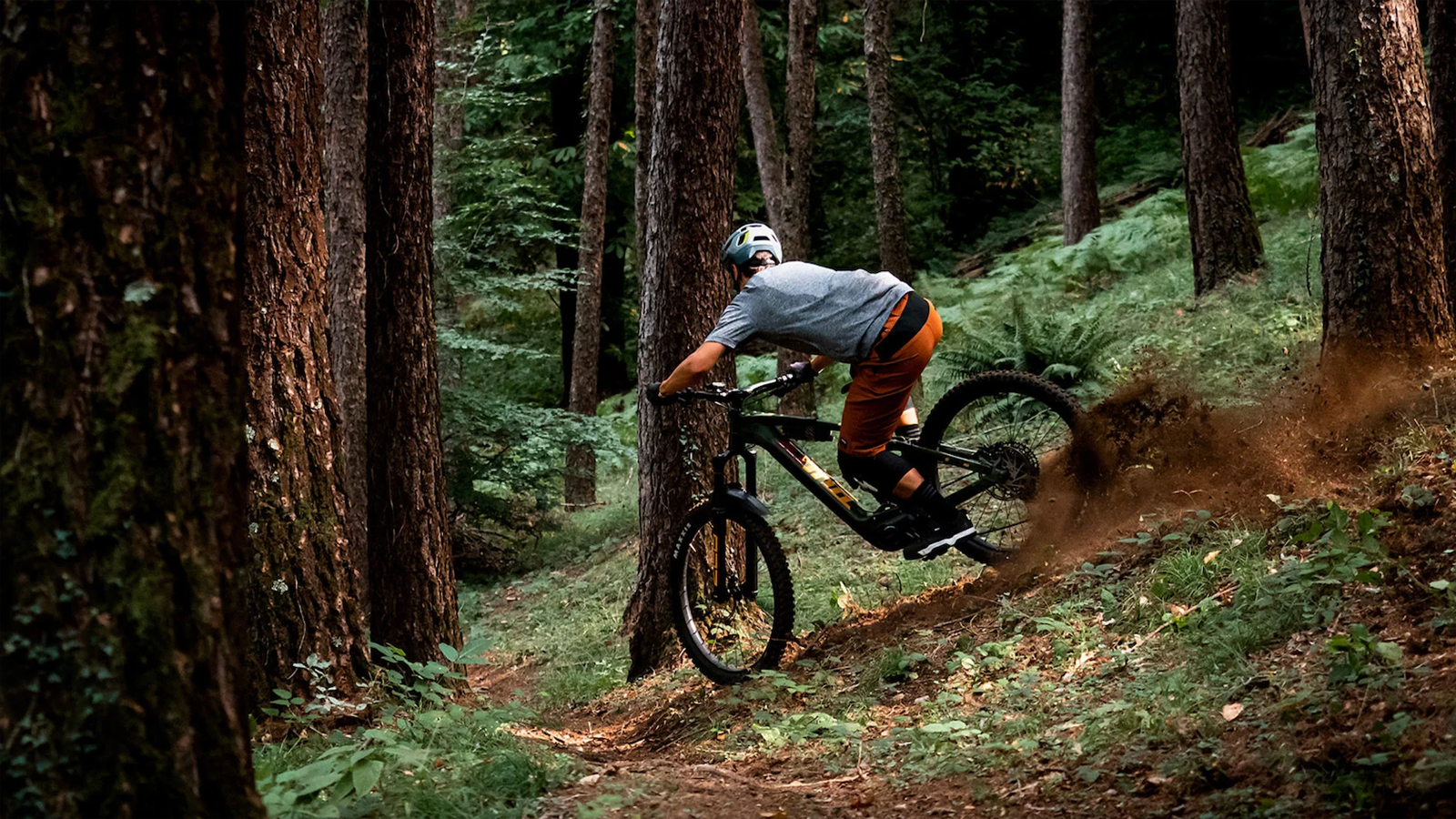
Many brands aim to offer the best MTB body armor to meet the specific demands of mountain bikers riding on modern bikes, exploring trails that are so well designed they allow for higher speeds (and sometimes higher risks) than ever.
The most commonly used piece of protective kit in your locker is likely to be your best MTB helmet, and beyond that, riders usually wear knee pads, elbow pads and MTB gloves. Nowadays, we’re also seeing more riders add a lightweight, unobtrusive protection layer under their jerseys to shield the torso, back or shoulders.
The best MTB body armor can be as stripped back as a simple back plate held in place by a mesh vest, through to fully-featured front and rear panels and incorporated shoulder guards. It stands to reason that the more protection you add, the greater the weight you'll need to carry. Also, extra materials and coverage should (but don’t always) impact on comfort, breathability and cooling.
How much body armor is enough is a personal choice that depends on the type of riding you do, although some enduro events (particularly abroad) demand some protection to enter. Meanwhile, with more and more regular riders visiting bike parks alongside the hardcore downhill brigade, many add MTB armor on uplifted days where trials are more demanding. Also, there’s less requirement for cooling when pedaling up long climbs if you’re sat in an uplift bus.
Our expert testers have put a variety of padded vests and jackets through their paces to come up with our pick of the best MTB body armor. Our overall best pick is the Fox Racing Baseframe Pro D3O, which offers serious protection as well as comfort and freedom of movement. Our best value choice is the lightweight and high-quality Dainese Trail Skins Air Vest.
Read on for our complete list of the best MTB body armor, or if you need help with what to look for when choosing protective gear, skip to the bottom of the article for our advice section.
The quick list
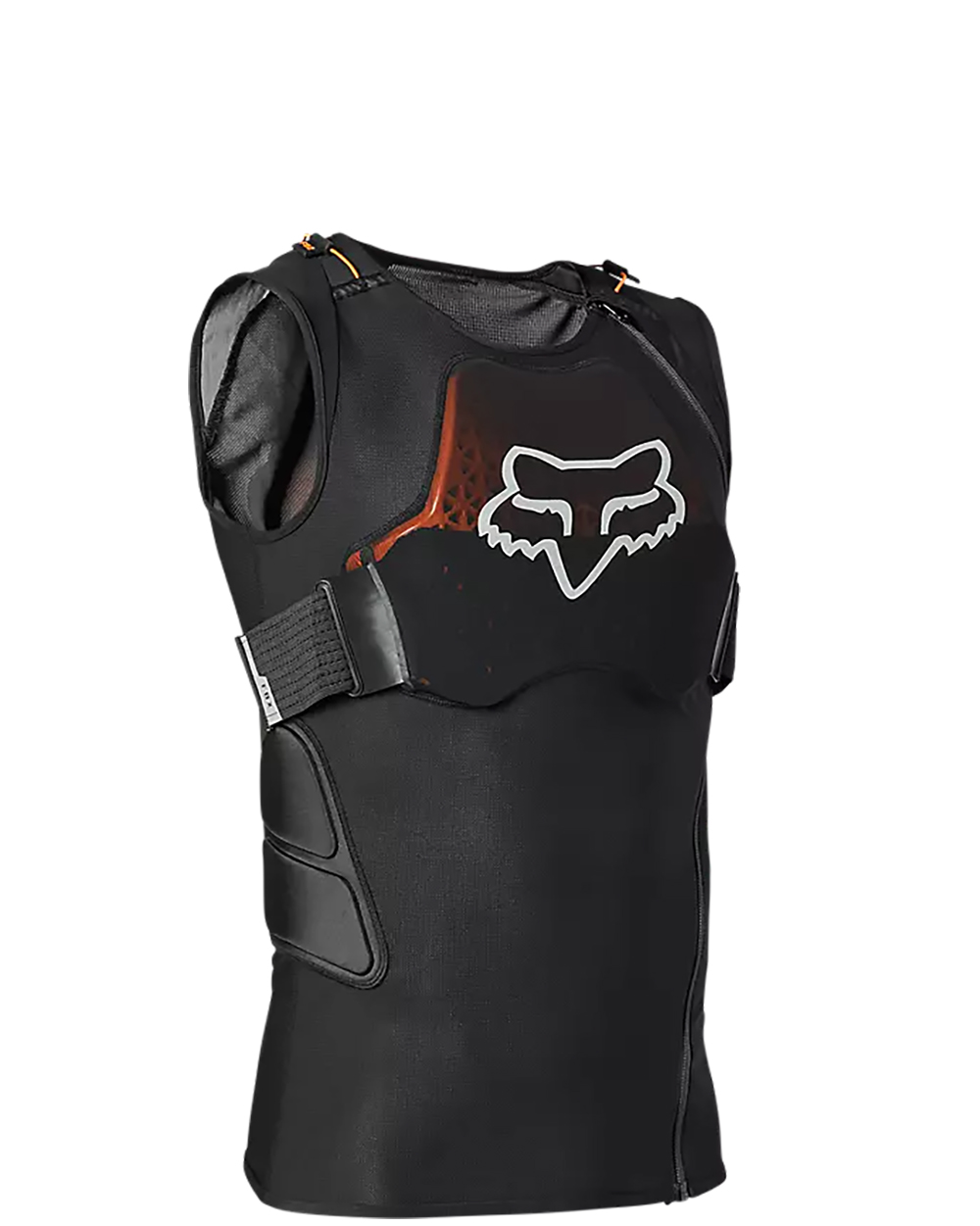
Best MTB body armor overall
A superb, class-leading product that balances serious protection, comfort, freedom of movement and cooling.
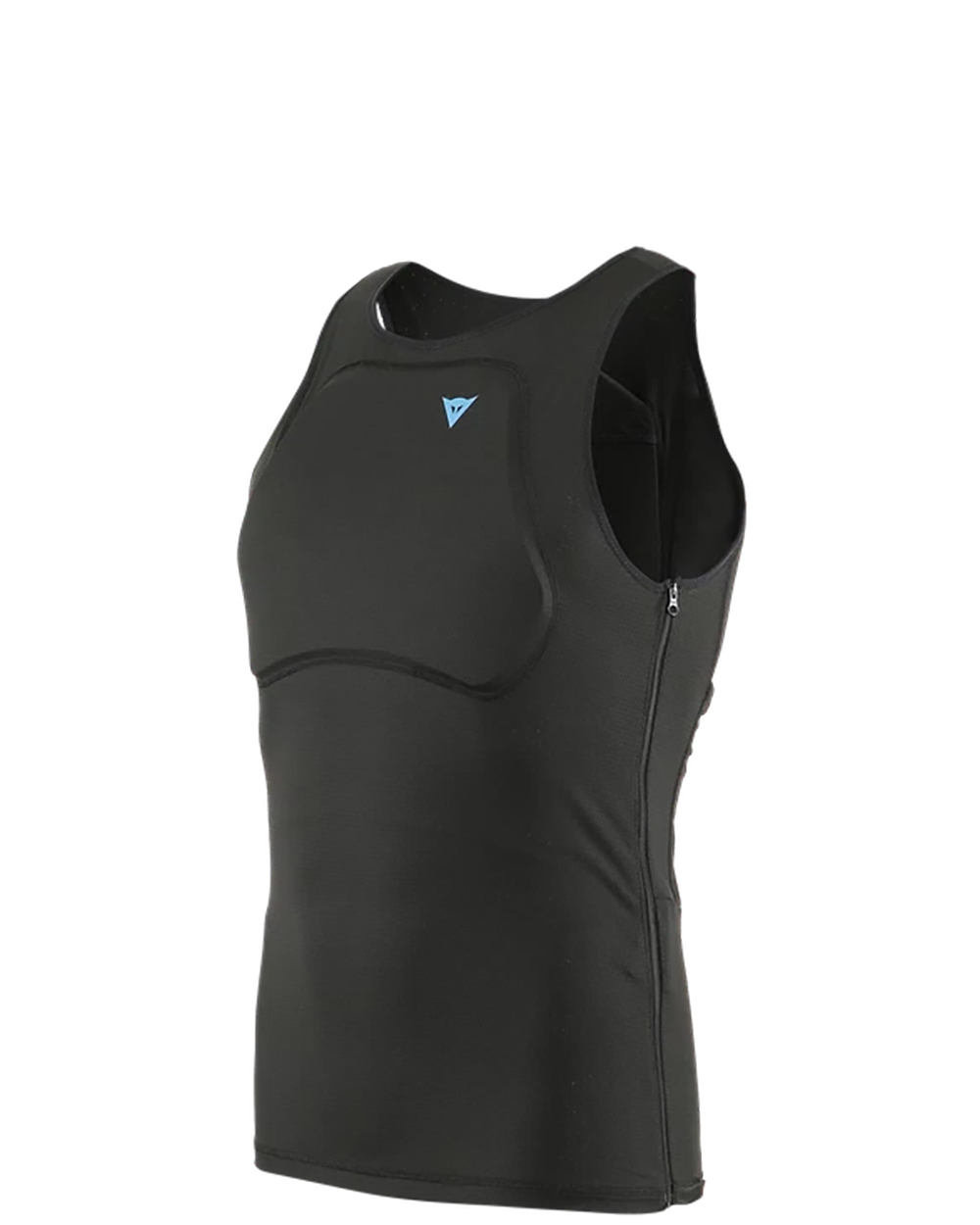
Best value MTB body armor
High-quality, affordable and lightweight front and rear protection that also doubles up as a spine protector.
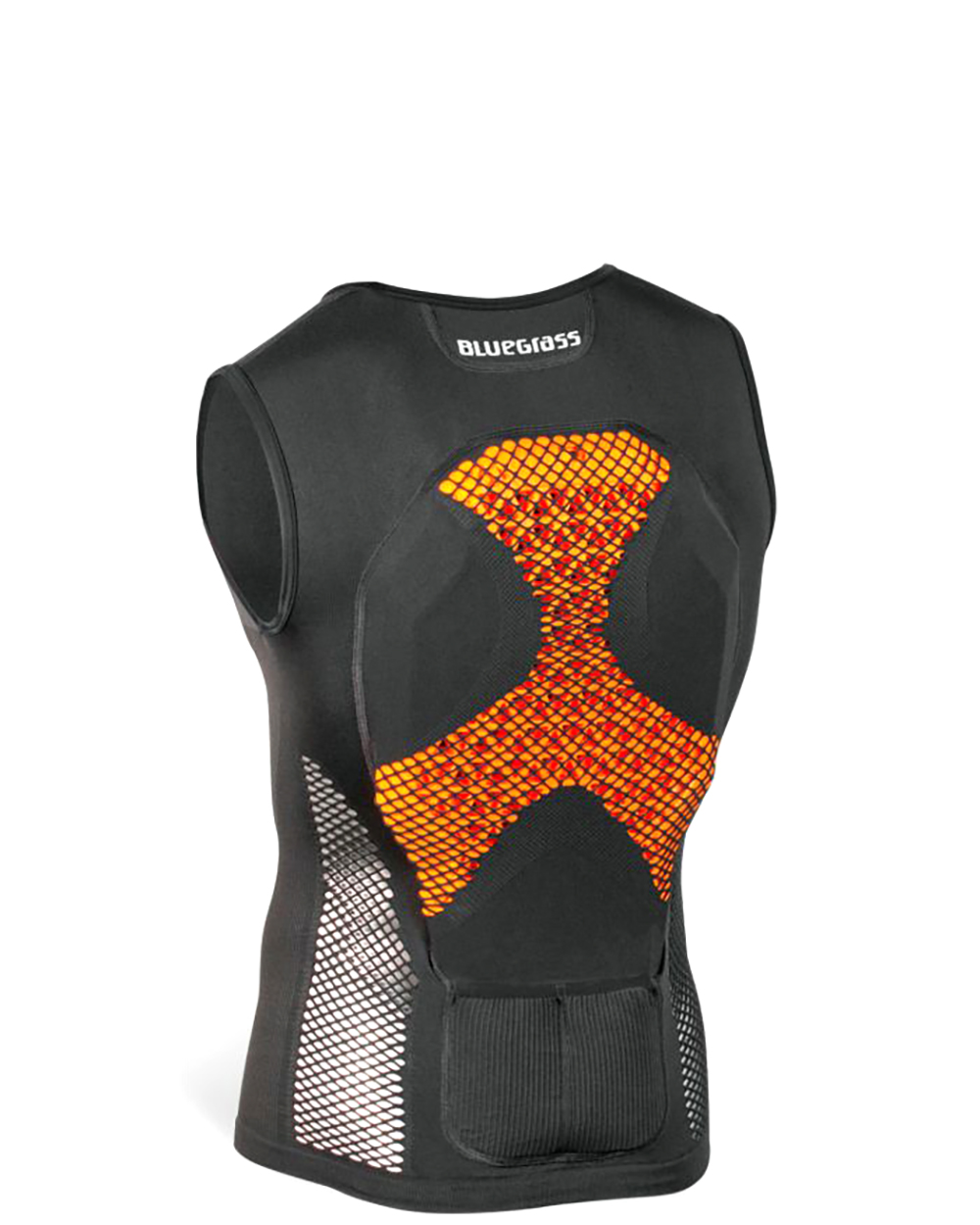
Best MTB back protector
Excellent, comfortable and body-hugging rear protection with exceptionally good wicking capabilities.
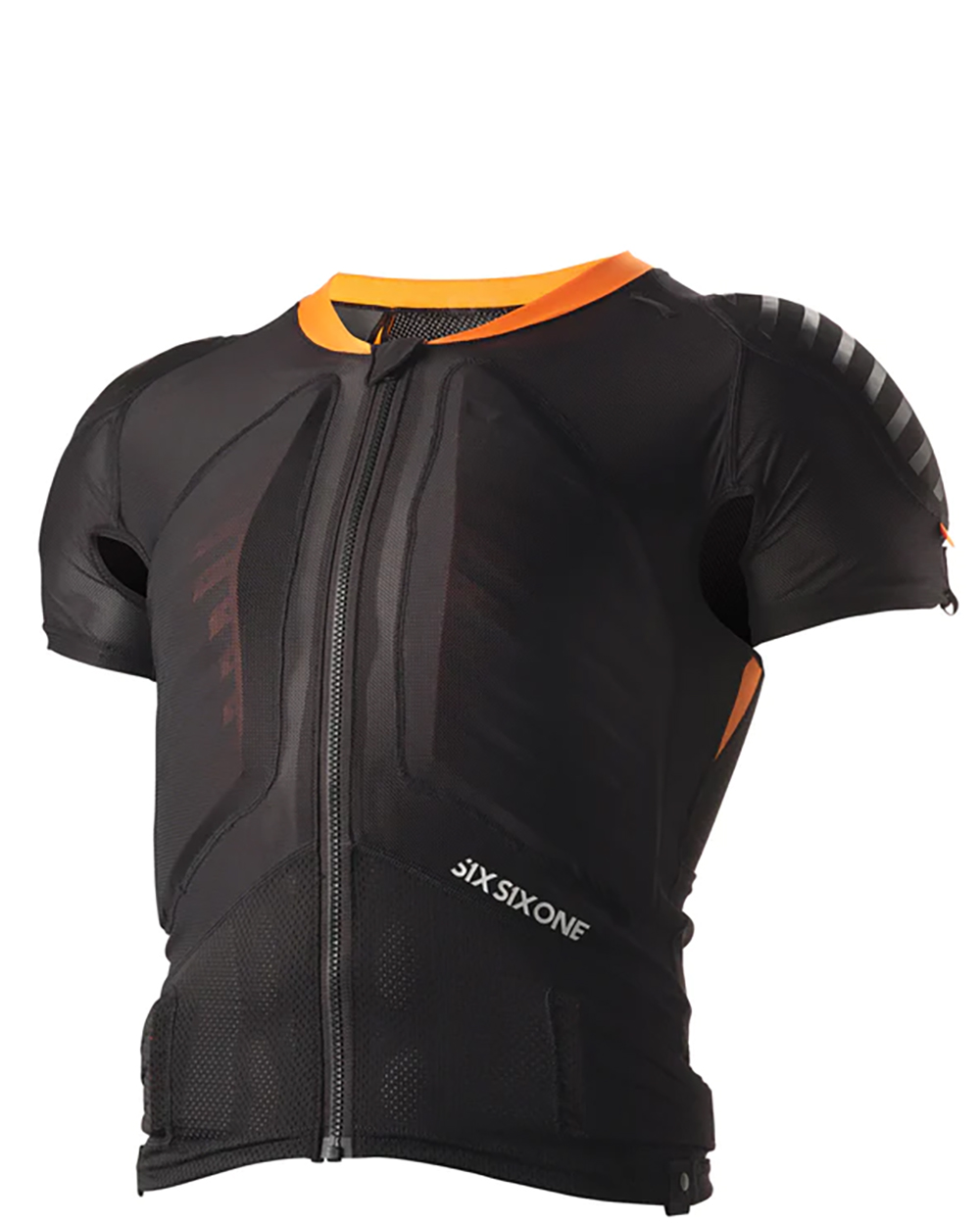
Best compression MTB body armor
A tight mesh ‘compression fit’ jacket with front, rear and extra shoulder protection.

Best hardcore protection MTB body armor
Seriously protective vest best-suited for enduro or DH riding/racing and above.
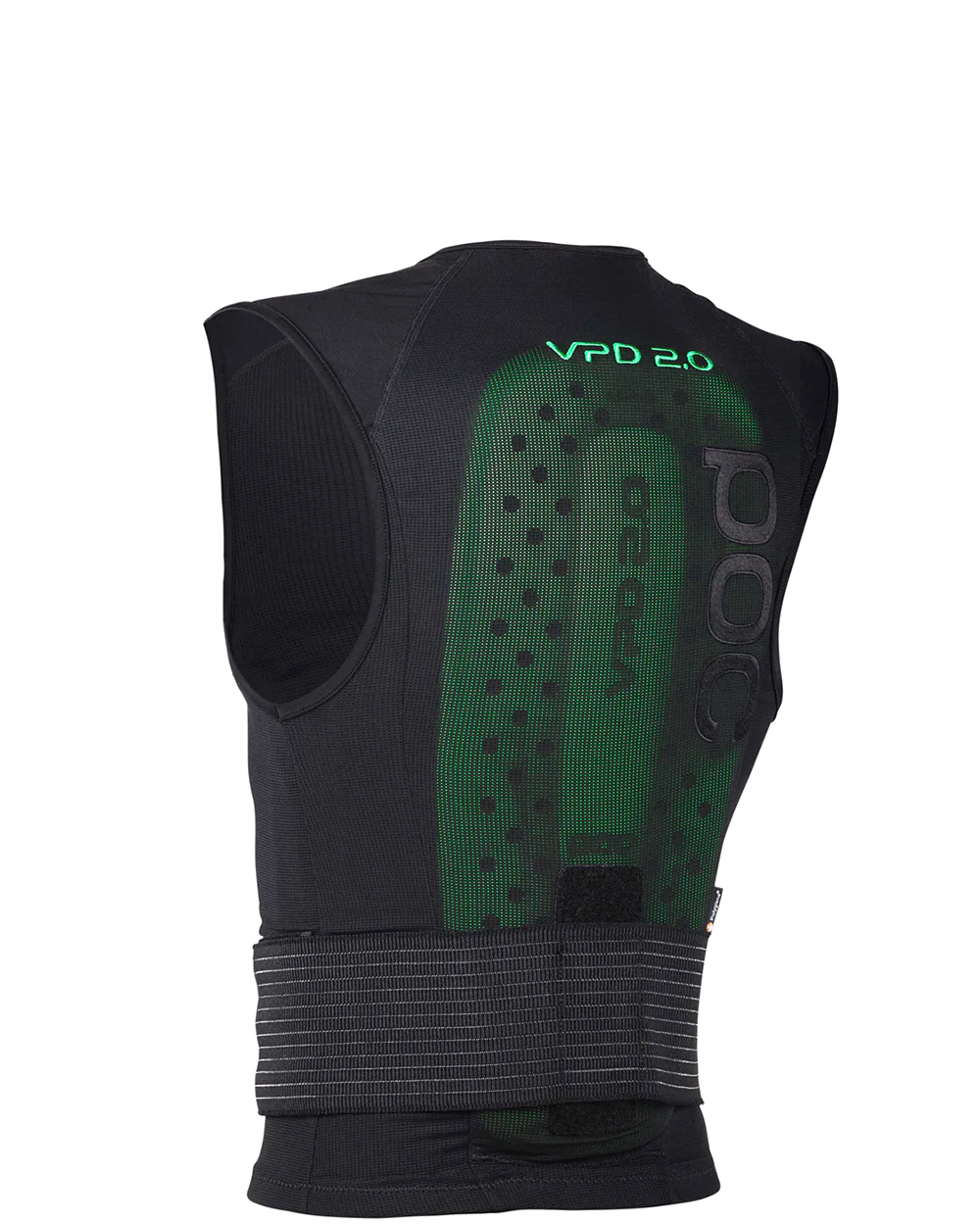
Best hardcore MTB back protector
A triple-layer backplate that offers excellent coverage both length- and width-ways.
The best MTB body armor
Why trust BikePerfect
1. Best armor overall
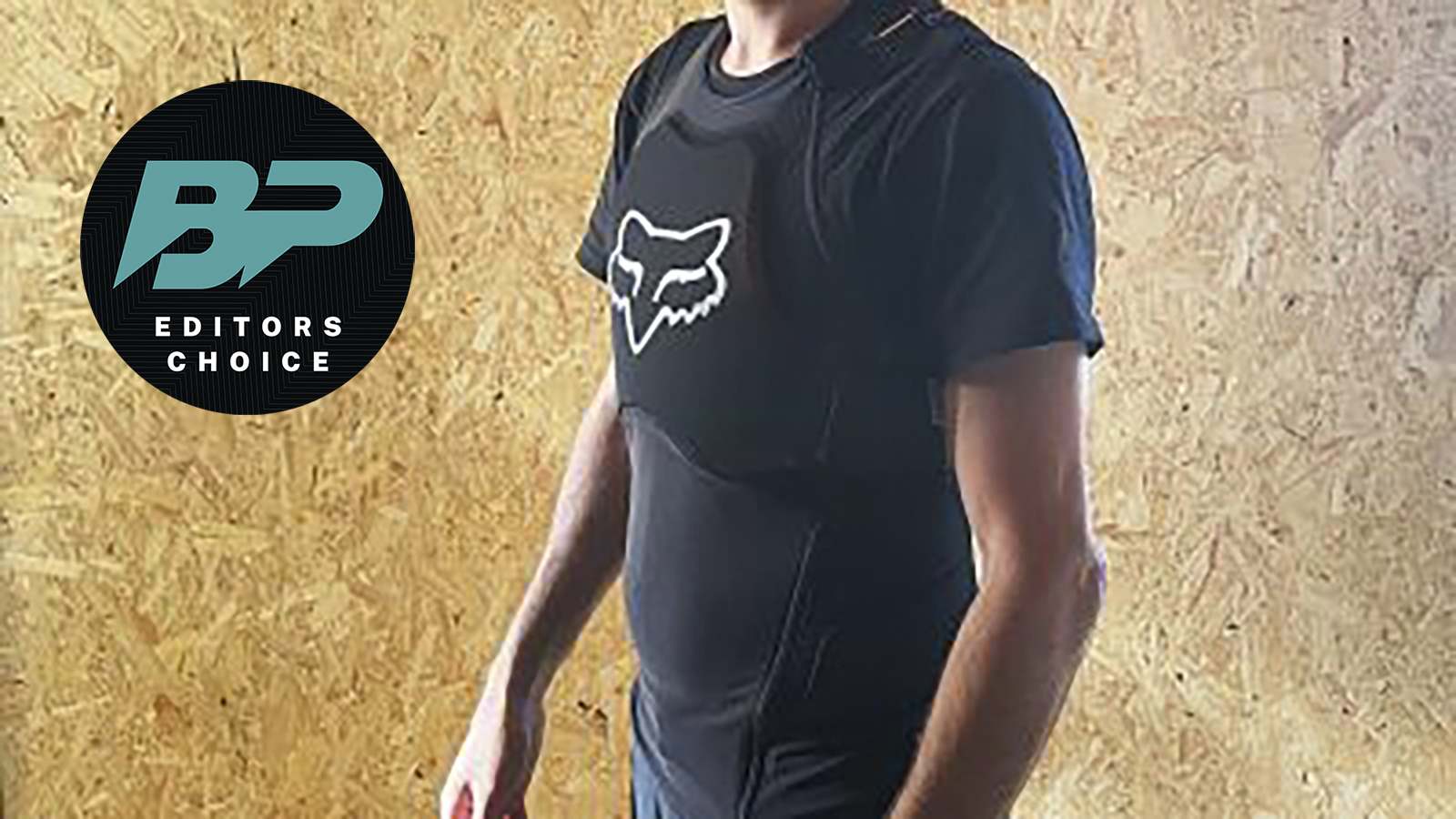
Specifications
Reasons to buy
Reasons to avoid
This Fox vest has a shaped chest guard and longer back plate extending almost from neck to coccyx. It also features separate, smaller pads to protect vital organs on the flanks above the waist.
The main armor uses one of the original impact-hardening polymers called D3O. Warmed up, it’s soft and conforming enough to flow with body movements until it's impacted, when it instantaneously becomes rigid to resist penetration and defend against strikes. It’s arranged here in a webbing mesh for better airflow and sculpted into a form-fitting profile.
Once in place and zipped into Fox’s vest (you need to thread your arms inside) you feel really protected and – using different zones and types of material – the super-soft, stretchy fabric is extremely effective at wicking moisture away. On top of this, underneath each of the main panels, a ‘spacer mesh’ slightly lifts it off the skin to allow more cooling airflow than most of its rivals.
The Baseframe’s snug fit doesn’t move an inch when riding and doesn’t impact on freedom of movement either. The back protection covers a big area, hugs in closely to the spine’s curves without ever riding up and interfering with the back of your helmet, even when sat in uplift vans. The chest panel covers the heart, lungs and ribs yet still seems to leave more room around the side of the pecs and underarm area than other protection vests do, allowing you to really rotate the shoulders and upper body.
Chunky protection here adds weight, there are no pockets or stashes for hydration bladders and the price is top end, but we can live with all this considering how well Fox has nailed the fit and function. Breathability, comfort and cooling is superb and this thing fits so well it’s low-profile enough to not make you look like an American football player, either.
Our reviewer Mick Kirkman summed up: "The fit’s almost invisible and, especially considering how safe you feel in it, mobility and comfort are superb."
For more info, see our full Fox Racing Baseframe Pro D3O review.
| Attributes | Notes | Rating |
|---|---|---|
| Protection | D3O panels front and rear | ★★★★ |
| Comfort | A great fit with cooling airflow | ★★★★★ |
| Weight | Adds over a kilo to your body | ★★★ |
| Value | Worth the high RRP | ★★★ |
2. Best value armor
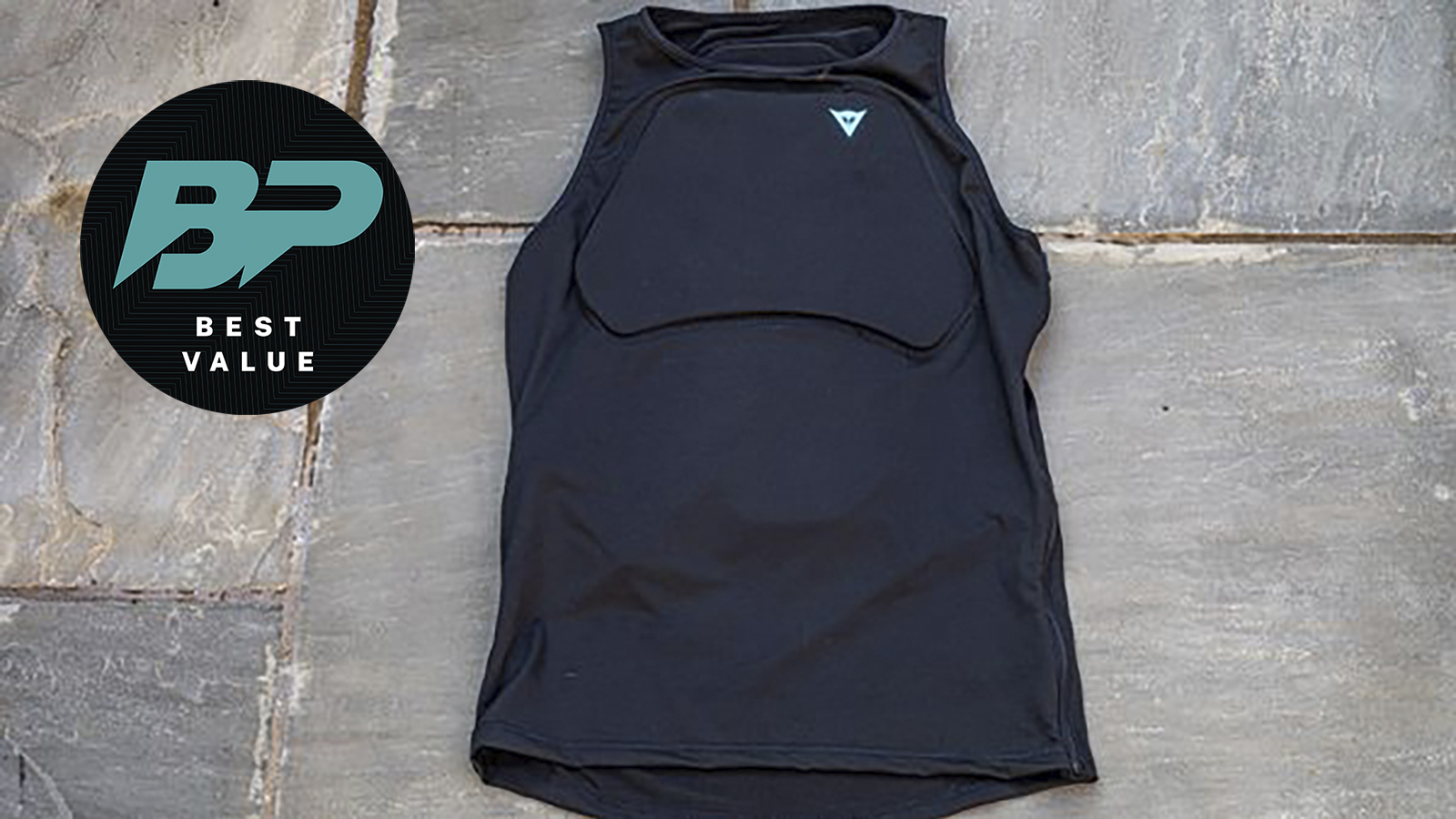
Specifications
Reasons to buy
Reasons to avoid
This Trail Skins Air vest is designed to be Dainese’s body protection with the most emphasis on freedom of movement, weight saving and ventilation. As such, it's the lightest we've tested. Despite being so lightweight, there’s still both front and rear protection with a minimal chest plate, and a longer (albeit thin) spine-protecting panel. Dainese also offers a version with shoulder pads called the Rival Pro Tee.
Both panels here are removable for washing, so you can take the chest panel out for an even lighter, more invisible feel if you want. The vest is also long enough to tuck into pant waistbands, which helps stop it riding up while riding.
Dainese’s pads are dense and solid to really protect you in any arguments with rocks, and also 55 percent open to enhance airflow. The panels comprise three independent layers that can slide over each other, but also twist and deform well so that it’s reasonably flexible once warmed up. Coverage here doesn’t extend to side ribs or organs at the back, so this vest is more about being so comfortable you can wear it on every single ride than offering maximum protection. We’d argue that makes it especially suited to aggro trail riders pushing hard or e-bikers who want a bit of protection for the longer distances and extra descents those bikes allow.
The Trail Skins vest sits pretty close to the body, although the back panel is a bit more disconnected from the spine’s curvature than some (like the Bluegrass vest) that totally traces the back and shoulders, and fits a bit more snuggly. Breathability and moisture wicking are effective (although again, not quite at Bluegrass levels – see below), and there are five sizes available to ensure a good fit. The price is also very competitive for double-sided protection.
Our reviewer Mick Kirkman said: "Where Dainese’s vest shines brightest is in being so noticeably lightweight, which means even with the chest and spine panels in place, it’s really easy to forget you’re wearing any protection at all, unless it’s a scorching summer day when heat does build up inside a little."
See our Dainese Trail Skins Air Vest review for more detail.
| Attributes | Notes | Rating |
|---|---|---|
| Protection | More for trail riders than DH | ★★ |
| Comfort | Lightweight and breathable | ★★★★ |
| Weight | The lightest armor we've tested | ★★★★★ |
| Value | A well priced piece of kit | ★★★★★ |
3. Best back protector
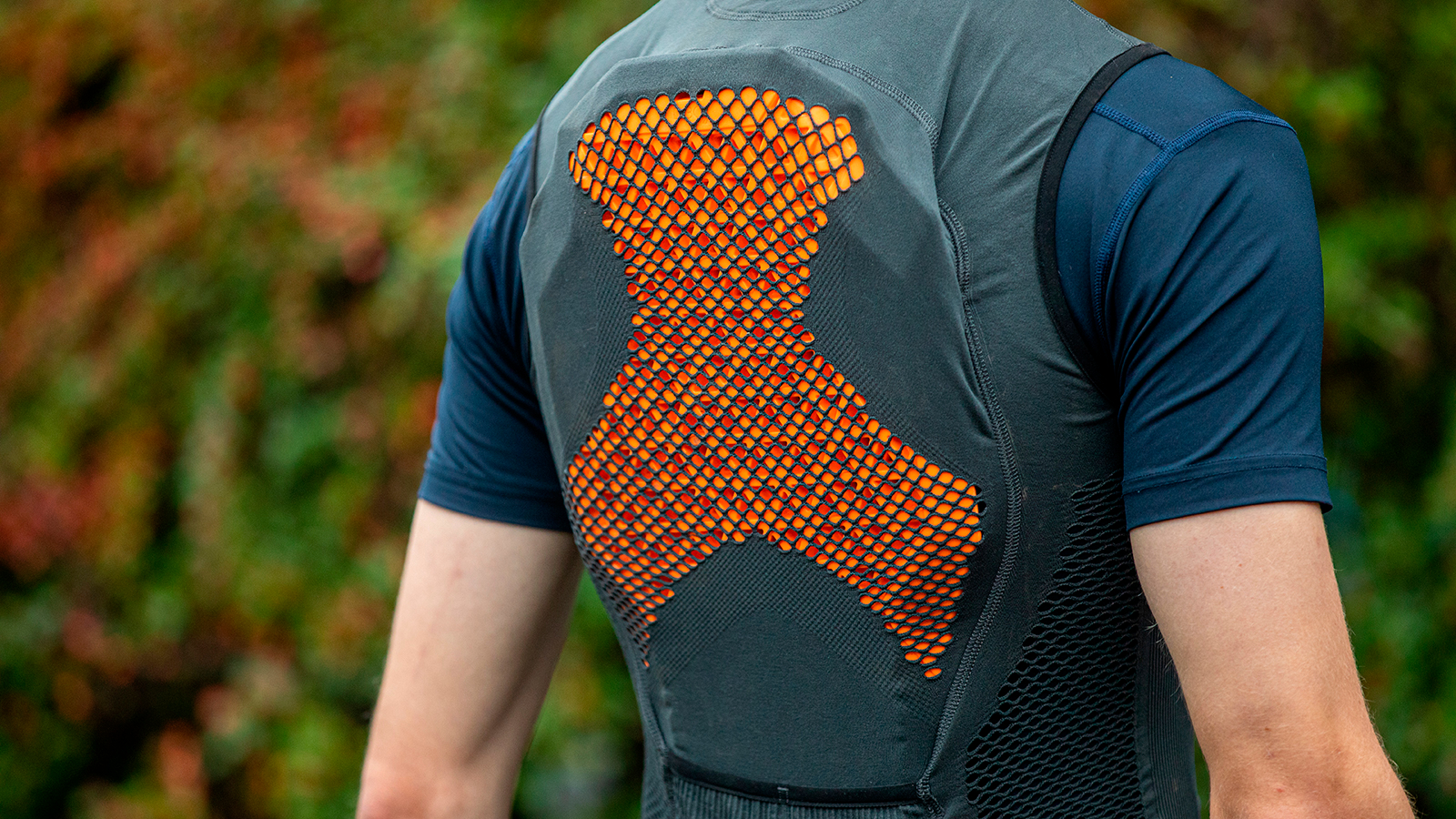
Specifications
Reasons to buy
Reasons to avoid
With an extremely light, near invisible feel when riding and a superb, body-tracing fit, this Bluegrass Seamless Lite D3O vest is a particular favorite. The main material body uses a soft microfiber fabric next to the skin, and the ‘Seamless’ part of the name refers to the fact the vest features a pullover design, instead of using any potentially bulky or heavier zips to secure it.
The extremely stretchy, Italian-made Dryarn fabric used in the construction is lighter than traditional materials, and delivers a gentle elasticated compression fit. It traces the body exceptionally well and there are also panels with a coarser mesh (more like a road cycling ‘string vest’) around the abs and under the collarbone, which dump heat and moisture faster than any rival products we’ve tested.
The wide back panel has broad coverage right across the middle and below the shoulder blades (not just over the spine) and also reaches right down the tail bone, with a shape that follows the back’s curvature. The impact-hardening D3O polymer used to construct this panel can be a bit stiff when first put on, but it soon heats up and conforms to body shape really well. The overall fit is low profile and extremely unobtrusive.
The fact this is vest is pulled on over your head means it’s not as easy to slip off or unzip on a boiling hot uplift, but with superb fit and cooling as good as this, that’s simply not an issue. Overall, Bluegrass’s vest feels less bulky than rivals in use and has class-leading moisture and heat management.
Our reviewer Mick Kirkman summed up: "Bluegrass’s Seamless Lite D3O vest is expensive, but the high price delivers a product so comfortable you’re inclined to wear it more often, rather than swerving it for reasons of comfort or temperature control."
For more, check out our full Bluegrass Seamless Lite D3O Back Protector review.
| Attributes | Notes | Rating |
|---|---|---|
| Protection | Top class back protection | ★★★★ |
| Comfort | Superb fit and breathability | ★★★★★ |
| Weight | D3O isn't light, but it's only on your back | ★★★ |
| Value | Premium price but works very well | ★★★ |
4. Best compression armor
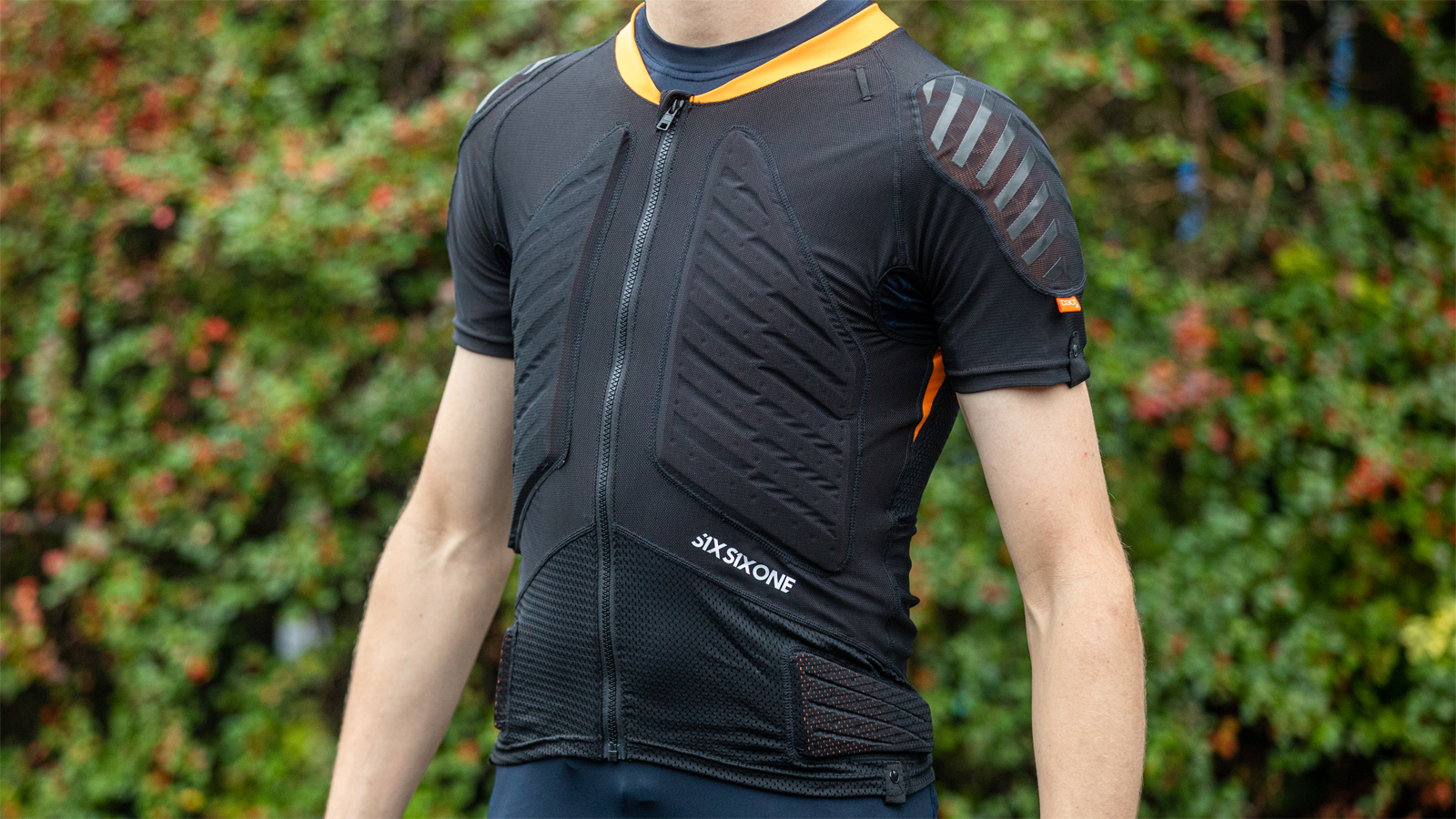
SixSixOne Evo Compression Jacket Short Sleeve
Specifications
Reasons to buy
Reasons to avoid
SixSixOne’s Evo offers a proper tight mesh ‘compression fit’ jacket with front, rear and also extra shoulder protection. A full long-sleeve version is also available for £20 more.
The Evo jacket uses the most well-known D3O impact-hardening polymer in both the well-shaped shoulder cups and rear spine panel. This orange material is impressively supple once warmed up by body heat, with the D3O panels appearing reasonably sturdy and protective, even without the higher Level 2 motorbike protection rating. The fact the pads are a bit thinner and floppier than some of their rivals affords superb flexibility to follow your body's movements precisely, especially when locked firm by the extra close fit offered here.
Comfort is excellent with no rubbing or digging in, and the string vest ‘regulating’ effect keeps you warmer on cold days while controlling heat build-up when working hard. There’s excellent freedom of movement while riding, but when you're sitting still in uplift buses, you do notice you're wearing body protection, as the pads can get a bit wriggled around when you're not on the bike.
There are two useful back stash pockets, while some riders will definitely welcome the ability to layer a hydration pack next to the spine protector.
SixSixOne's jacket does get a bit sweaty next to back panel; possibly not helped by the multiple perforations designed to aid air flow staying ‘closed’ due an excess of fabric bleeding over vent holes in production. The front chest protection and coverage isn’t as broad as with other products on the market, such as the Fox. While the back panel extends wide higher up to protect shoulders and ribs, more padding further down the spine might better protect the lowest vertebrae.
| Attributes | Notes | Rating |
|---|---|---|
| Protection | Front and rear coverage but smaller D3O panels than some | ★★★ |
| Comfort | Excellent fit but can get sweaty | ★★★ |
| Weight | Good protection to weight ratio | ★★★★ |
| Value | Premium price | ★★ |
5. Best hardcore protection armor
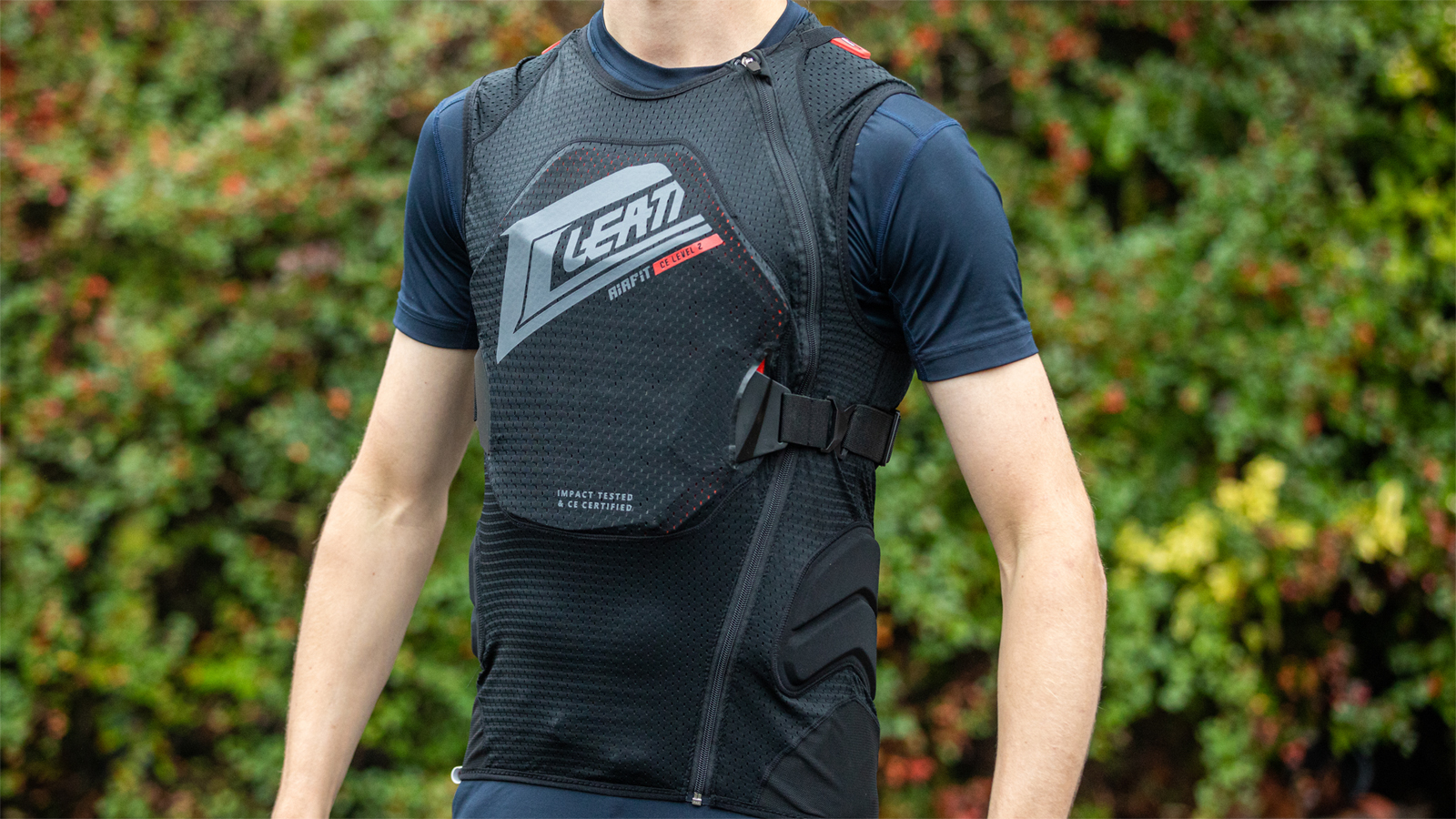
Leatt 3DF AirFit Vest
Specifications
Reasons to buy
Reasons to avoid
This 3DF AirFit vest is seriously protective and arguably best-suited for enduro or DH riding/racing and above, rather than trail riding.
Its soft and flexible energy-absorbing padding packs full motor sports-level impact certification on both chest and back panels (the only jacket in this guide for which this is true), and is made of foam layers that turn into a harder material on impact. Panels are removable so you can stick the AirFit vest in the washing machine, while ridges of softer, perforated foam isolate where the vest contacts skin, providing extra comfort and cushioning that really works.
Putting on the vest requires a separate elastic wrap cinching, but this strap helps chest and spine panels to better conform to your body shape, improves stability and reduces how much the 3DF sticks out. Additional foam flank protection pads also help to protect your kidneys.
Strapped into Leatt’s vest, it’s clear there’s some serious protection and the impression that even if you stove yourself into anything that isn’t moving, you’re going to come out of any exchange way better than without it.
Leatt’s fit and fabrics are top quality, with good wicking and quick drying properties, while airflow is also surprisingly good for armor that offers so much protection. This is part because the softer foam ridges hold the main pads slightly off the skin, allowing hot air and sweat to easily vent and escape.
For riders looking for the maximum protection that’s still comfy enough to pedal about in, this definitely means business, though the main drawback is extra weight, which is more noticeable when riding dynamically than with a simple back plate vest.
| Attributes | Notes | Rating |
|---|---|---|
| Protection | Serious front and rear protection | ★★★★★ |
| Comfort | Decent airflow but bulky and can run hot | ★★★ |
| Weight | Extra protection comes with a weight penalty | ★★★ |
| Value | Heavy duty protection doesn't come cheap | ★★★ |
6. Best hardcore back protector
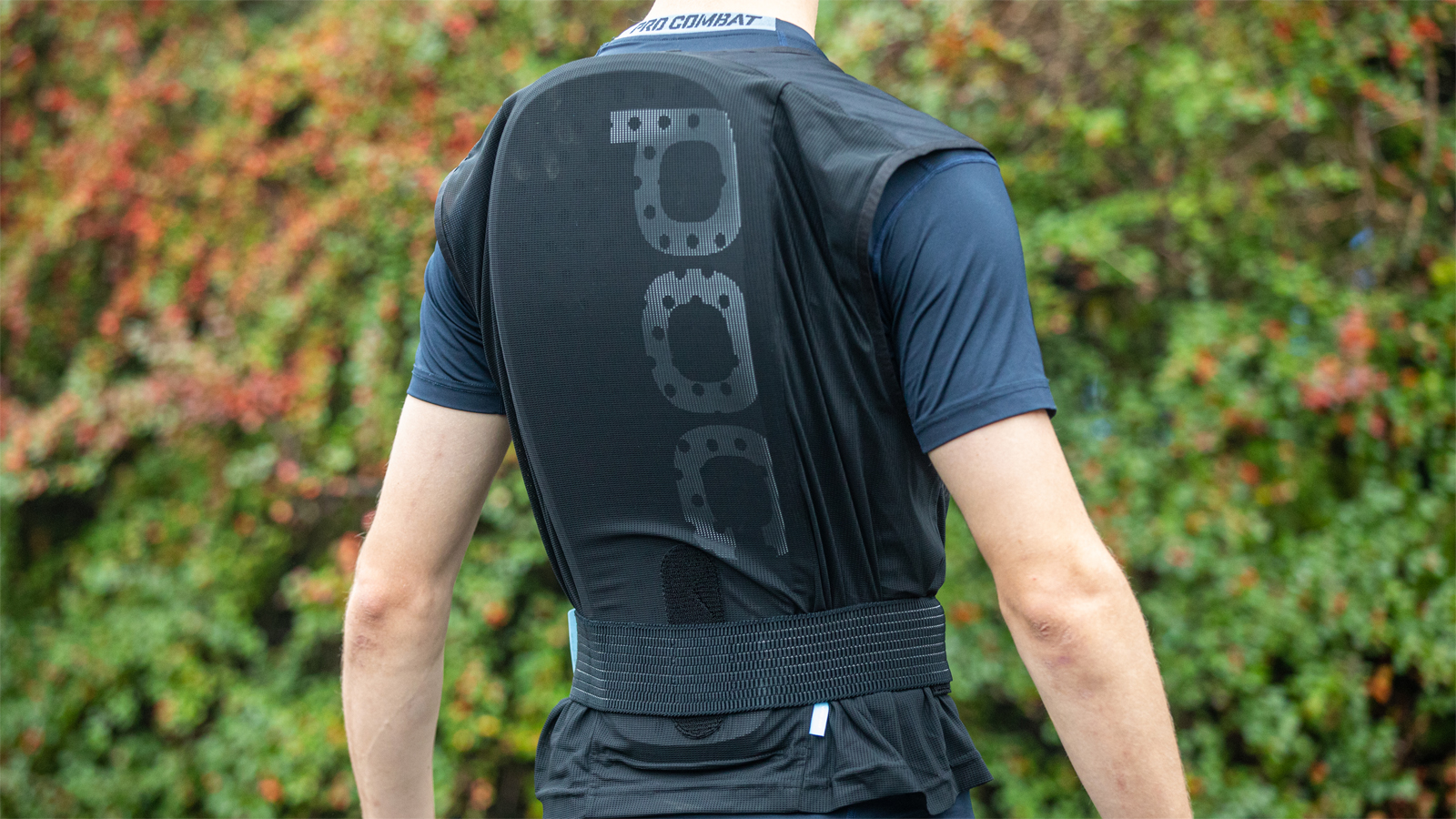
POC Spine VPD 2.0 Vest
Specifications
Reasons to buy
Reasons to avoid
POC are known as a top-end manufacturer, so it’s no surprise to see a well-made vest with quality materials here. Less expected, however, is that the Swedish brand's Spine VPD Vest comes in at a price point that’s actually at the lower end of the market.
The Spine VPD offers a triple-layer backplate with varying thicknesses and densities to absorb impacts. This is shielded by a soft foam-backed mash fabric where the panel makes contact with the spine. This backplate has excellent coverage both length- and width-ways but it's a bit flat, and less sculpted to the body’s curves. There are no supplementary pads for the coccyx or your sides.
POC offer three sizes (think torso length) in both slim and regular fits, and you need to pay attention to the generous sizes because the size large vest here is more like an XL for other brands, with a backplate that was too long for me at 176cm. The second tester (194cm) had no issues.
The Spine VPD’s main fabric is almost identical to Dainese’s, a micro-mesh material with very fine holes that also do a very good job of shifting moisture outwards. The material has excellent stretch to offer freedom of movement, and there’s also an optional (very broad) waist strap that fixes to the outside of the vest/backplate via a Velcro panel. This helps stabilise the (otherwise flappy) back panel, which – as mentioned – isn’t as curved to the arch of the back as some of its rivals.
Because the back panel covers a big area and also seems to be stiffer lengthways than against twisting, it has a tendency to get pushed upwards and out, and can ride up and peel off the back more than more shaped D3O or flexible, rubberized protectors on offer. This means it can also stick out a little through a jersey at the shoulder blades, which may not suit riders looking for a more invisible look.
| Attributes | Notes | Rating |
|---|---|---|
| Protection | Full length, heavy duty spine protection | ★★★★★ |
| Comfort | Not as sculpted as some | ★★ |
| Weight | At the heavier end for back only protection | ★★ |
| Value | Excellent quality for the price | ★★★★ |
How to choose the best MTB body armor
Is the best MTB body armor comfortable enough to wear on long pedal days?
The cut and type of fabric protection pads are fixed to is crucial to cooling, comfort, sweat absorption and even how smelly you get on the trail. Most vests use stretchy, perforated mesh synthetic fabrics with wicking properties, with some better than others at drying or dumping rider moisture. A closer fit ensures less wriggling and better insulation, too.
What protection is offered in the real world?
Many brands offer multiple levels of protection, from simple back panels and short-sleeve options with shoulder pads, through to long-sleeve jerseys that also incorporate elbow guards. Some products squeeze in extra pads to protect kidneys, coccyx and ribs (and even pockets to stash ride essentials), which are all useful additions provided they don’t add bulk.
Are vests or full jackets best?
This obviously depends on your needs, and we’d consider extra protection if you only ever use armor at a bike park. But it’s a serious commitment to pedal and climb a lot in a full jacket (in warm weather especially). Getting into the habit of wearing a relatively unobtrusive vest on every ride at least offers some back and rib protection that could be very useful.
What do the different protection certification levels mean?
EU protection certification is split onto two levels, 1 and 2, referring to the amount of impact force the padding absorbs.
To meet CE level 1 standards, padding must ensure that forces transmitted by a 5kg weight from a distance of 1m to the wearer are lower than 18kN, with no single value exceeding 24kN.
CE level 2 standards demand that the forces transmitted don't exceed 9kN, with no single value in excess of 12kN). The level 2 cert is usually for motorsport scenarios, where speeds and impact forces tend to be higher.
What is the padding made out of?
Many pads here use impact-hardening polymers that remain flexible until they experience high-velocity impacts. Names like D3O, Sas-Tec and X-Matter essentially describe similar technologies. The only potential drawback to these materials is that they can be a bit stiff in cold weather, until body heat ‘loosens’ the padding. Other constructions include EVA polystyrene similar to helmet liners built onto a flexible matrix.
How we test the best MTB body armor
We've tested out this body armor over many months in a variety of weather conditions. We've assessed the items for the level of protection and coverage offered, but also for fit and comfort, mobility, breathability and wicking, and how the fabrics cope after washing.

An ex-elite downhill racer, Mick's been mucking about and racing mountain bikes for over 20 years. He's tested a huge range of body armor and knows what to look for when you're after some extra protection.

An ex-elite downhill racer, Mick's been mucking about and occasionally racing mountain bikes for over twenty years. Racing led to photo modelling and testing kit for magazines back in the day, and, nowadays, he's mostly riding enduro-style terrain on conventional and electric bikes. As curious as ever about products and tech, he's as likely to be on the other side of the lens or computer screen rating, reviewing and shooting all the latest gear. Mick's list of regular clients includes Bike Perfect, MBR, MBUK, and most of the leading UK MTB publications at one point or another.
- Rich OwenEditor, BikePerfect
